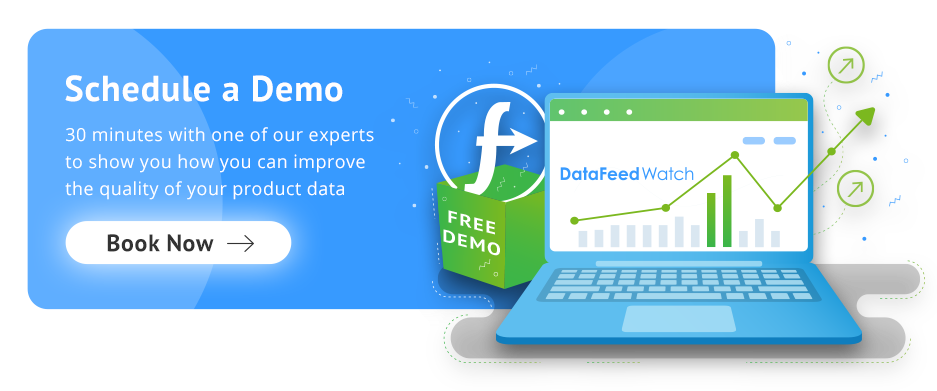Amazon is not just an e-commerce platform; it's a colossal marketplace with over 310 million active users and more than 9 million sellers globally. Its array of merchant-friendly features has made it a go-to platform for businesses and individuals looking to tap into the thriving world of e-commerce.
However, for newcomers, understanding its many features can be a challenging task. This comprehensive guide is crafted to demystify the process of selling on Amazon, answering common questions that new sellers often grapple with. We'll delve into each topic to give you a step-by-step walkthrough on how to get your products listed and sold on Amazon.
So, if you're ready to embark on your Amazon selling journey, keep reading and unlock the keys to successful selling on one of the world's largest online marketplaces.
1. Create your Amazon selling strategy
If you want to start an Amazon business, crafting a solid business plan can make all the difference. Your Amazon business plan will give you a roadmap to success, outlining your goals, strategies, and tactics for reaching them. Crafting a great plan can be daunting, but with the right knowledge and guidance, it doesn't have to be.
Start by identifying which products you want to enter Amazon with, researching your competition and target audience, and outlining your budget and marketing plan. By following the right formula and staying true to your vision, you can create a thriving Amazon business that will bring in profits for years.
a. How to identify which products to list on Amazon?
To establish your unique space in the Amazon marketplace, follow these simplified steps:
- Explore Trending Products: Begin by studying the "Best Sellers" on Amazon to understand what's popular, or read this article about best-selling niches on Amazon.
- Survey the Competition: Check reviews and ratings of top sellers in your potential niche. Avoid areas with excessive competition or extremely low rivalry, which could indicate low demand.
- Spot Market Gaps: Identify product categories where demand surpasses supply. Consider customer feedback on existing products to pinpoint and address common issues.
Validate your niche choice using tools like Google Trends to ensure consistent demand. Account for product seasonality and long-term potential to guarantee a steady Amazon business income.
b. How to identify the best supplier on Amazon?
- Research supplier ratings and reviews: Look for suppliers with consistent positive feedback.
- Evaluate product quality: Always order samples to check the quality of the products.
- Look for suppliers with fast shipping: Fast shipping is crucial to Amazon customers, as they expect timely deliveries.
- Ensure that they have strong customer support: A supplier with excellent customer service will make your life easier when issues arise.
For example, BrandsGateway is a supplier that offers dropshipping and wholesale services, providing sellers on Amazon with access to a vast range of luxury clothing and accessories. With over 24,000 products from top brands like Gucci, Prada, and Dolce & Gabbana, they can help you integrate high-quality fashion items into your Amazon store. This makes it easier for you to offer premium products while focusing on growing your business.
c. What kind of budget do you need to start selling on Amazon?
Starting an Amazon business requires an initial investment that can range from a few hundred to several thousand dollars, with the median being around $3,836, according to Jungle Scout.However, this is a median value, and the actual amount can vary widely depending on your business model, the products you plan to sell, and the scale at which you intend to operate.
If you're starting small, with a low-cost product and a conservative inventory, a $500 to $1,000 investment might suffice. But if you're launching with a high-end product or a large inventory, you might need an investment of $10,000 or more.
When estimating your budget, consider costs such as product sourcing, Amazon seller fees, shipping and packaging, and marketing and advertising. Don't forget to factor in the costs of sample products, product inspections, branding, and photography. Remember, the more thorough and realistic you are in your budget planning, the better prepared you'll be for the journey ahead.
Return to top of page or Double Your Amazon Sales With 9 Proven Tips
2. Set up your Amazon seller account
Before diving into the Amazon marketplace, you'll need to set up your seller account. You can either use your existing customer account or create a new Amazon seller account with your business email. Here is a checklist of requirements for becoming an Amazon seller:
- An existing Amazon customer account or a business email for a new Amazon seller account
- An internationally chargeable credit card
- Valid Government ID (this is for identity verification which helps protect both sellers and customers)
- Relevant Tax information
- Contact phone number
- A bank account where Amazon can send the proceeds from your sales
Remember, these requirements apply to residents who are eligible to sell on Amazon. Make sure you have all these in place before you sign up to ensure a smooth start to your Amazon selling journey.
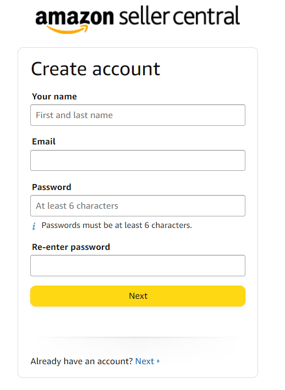
Set up Amazon seller account | Amazon
a. Which Selling Plan should I choose?
There are two types of Amazon seller accounts, Individual and Professional. While setting up a seller account, you will become an individual seller by default. If you want to be Amazon Professional seller, you need to opt-in to the Professional account.
The Professional Amazon Seller
A professional plan is recommended for most merchants. It gives you access to advanced selling tools and Amazon Advertising. You also can use Amazon’s API and access reports. Both are useful if you want to connect to 3rd party tools or dive into your sales data. Also, certain product categories are restricted and are only available for professional Amazon sellers. The cost of this plan is $39.99 per month in addition to referral fees.
The Individual Amazon Seller
Consider an individual plan if you sell only a few items per month (less than 40) or aren’t ready to start selling yet. This plan is more limited, but you can still list items on Amazon and use Fulfillment by Amazon (we’ll cover that later). The cost of this plan is $0.99 per item sold in addition to referral fees.
If you need more information to distinguish the Amazon Professional Seller vs. Individual account attributes, see a detailedfeature comparison of the plans.
b. How much are Amazon selling fees?
Amazon provides a great opportunity for merchants to sell products, but you can’t sell on Amazon for free. It takes a portion of the revenue of each item sold before depositing your share into your seller account.
Each time you sell an item on Amazon, you are charged a referral fee. The referral fee is Amazon’s cut of the item’s total price. Referral fees are charged in addition to the selling plan fees. The total price includes the item price, shipping cost, and any gift-wrapping charges. Referral fees range from 8% up to 45% and depend on the product category. Some categories have a per-item minimum referral fee. Referral fees apply to all products sold on Amazon.
For media categories (Books, DVDs, Music, Software, Video), sellers also pay a $1.80 closing fee per media item sold. This fee only applies to media categories and does not apply to non-media categories.
To learn more about the exact referral fees per category, check Amazon’s Category Referral Fees schedule.
c.What is the difference between Amazon FBA and FBM?
Merchants selling on Amazon have two options for storing and fulfilling their items: FBA & FBM. They can manage all the logistics themselves or outsource it to Amazon.
Fulfillment by Amazon (FBA)
With Fulfillment by Amazon, a seller sends their inventory to Amazon’s warehouses. Amazon stores the inventory and ships it to the customer. Added benefits are that Amazon handles customer support, and items are often sent with 2-day Prime shipping.
When you use FBA, Amazon will charge both a fulfillment fee and a monthly inventory storage fee. The fulfillment fee covers all the picking, packing, shipping, and providing customer service. The monthly inventory storage fees cover the space occupied by your products in Amazon’s fulfillment centers.
Fulfillment by Merchant (FBM)
With this method, a seller manages all the storage, shipping, and customer support themselves. To participate in Amazon Prime, the seller will need to enroll in Amazon Seller Fulfilled Prime (a topic we will cover later in this article).
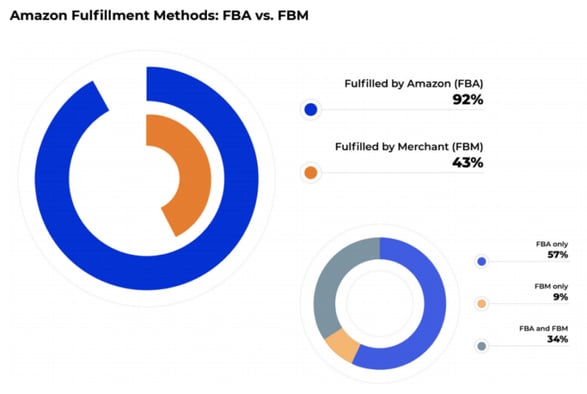
The use of each fulfillment type across Amazon sellers | Jungle Scout
Return to top of page or Double Your Amazon Sales With 9 Proven Tips
3. Get your products listed on Amazon
When you want to start selling on Amazon, there are two options. Your first option is to match your product to an existing product detail page in Amazon’s catalog. If your product doesn't yet exist in Amazon’s catalog, then you can create a new product detail page for the product.
When you use matching, you create a selling offer for an existing item. You need to add your offer details which include the product's condition, price, quantity, and shipping options. You can update your offer details at any time. This method is relatively simple, as you don't need much data to start. All sellers with offers for the same product will compete for the Buy Box, a topic covered later in this article.
Creating a new product in Amazon’s catalog is more involved than matching. With this method, you will create a new item on Amazon that wasn’t there before. This method requires the following information:
- Product Identifier - UPC, EAN, JAN, or ISBN
- Offer details - condition, price, quantity, shipping options
- Product Details - name (title), brand, category, description, and images
- Keywords and search terms
Note that adding a new product listing on Amazon when one already exists violates Amazon’s policies. Amazon doesn’t allow multiple product detail pages for the same product, and any duplicate pages are eventually merged.
Unless this new product is protected using Amazon’s Brand Registry (more on that topic later), other sellers can create their own offers on the new product detail page.
.png?width=913&name=pasted%20image%200%20(2).png) A product detail page on Amazon | Amazon
A product detail page on Amazon | Amazon
a. How to add products to Amazon?
Whether you are matching or creating new products in Amazon’s catalog, there are 3 basic ways of adding products to Amazon:
- One by one, using the ‘Add a product’ feature in Amazon Seller Central
- Uploading inventory files to Amazon Seller Central
- Using a 3rd-party automated feed solution
Adding products to Amazon one-by-one
The simplest way to list products on Amazon is by using the Add a Product feature. In this method, you add product information manually inside the Amazon Seller Central admin panel of your account.
This is a great way to start with Amazon’s product addition process, but you’re limited to adding products one by one. This is fine for a few products but is difficult to scale up.
Uploading inventory files to Amazon
Amazon has inventory file templates for matching and creating new products. You download these Excel-based files from Amazon Seller Central, populate them with your product data, and upload them when you are done.
This method is good for adding a large number of products, but you’ll need to be comfortable with using Excel files.
Uploading products to Amazon via automated feed tools
Another way to add products to Amazon is through an automated feed. With the method, a merchant connects their data source (like a shopping cart) to a 3rd-party solution that uploads that data to Amazon.
This allows sellers to add many new products to Amazon easily and systematically. In addition, good feed tools allow you to edit and manage your source data.
At DataFeedWatch, our Amazon integration uses a powerful rule-based mapping engine that gives you control over your data. Our integration gives you the tools to customize your product details specifically for Amazon and build higher-performing listings.
Contact our sales team and schedule a demo to learn more about our Amazon integration.
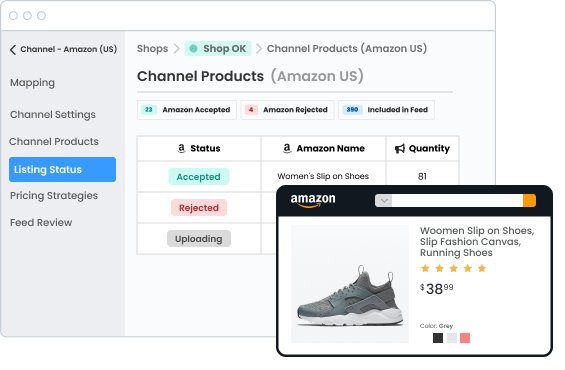
Marketplace management solution | DataFeedWatch
b. What is Amazon ASIN?
When selling on Amazon, you’ll hear the term ASIN used a lot. An ASIN is an Amazon Standard Identification Number. Every product on Amazon has one, and when you create a new product detail page, you must create a new ASIN.
When people refer to an “ASIN,” they often refer to the product itself and not just its number. It’s useful to know that the terms listing, item, product, product detail page, and ASIN are used somewhat interchangeably.
For more information on creating new products and ASINs, see our detailed article onhow to create new ASINs.
c. What do you need to know about Amazon pricing?
Amazon pricing is a crucial aspect of your business strategy. The price of your products can significantly influence your visibility, competitiveness, and profitability on the platform. Amazon uses a dynamic pricing model, which means prices can change frequently based on factors such as demand, stock levels, and competitor pricing. Therefore, having an effective pricing strategy is paramount to success.
There are various strategies that sellers can utilize to optimize their pricing on Amazon. One common approach is the 'Competitive Pricing Strategy,' where sellers price their products hand in hand with or slightly below their competitors to attract price-sensitive customers. Another approach is the 'Value-based Pricing Strategy,' which is based on the perceived value of the product by the customers rather than the actual cost or the competitors' prices. You can read more about Amazon's pricing strategies here.
d. What are Amazon product listing requirements?
When discussing how to list products on Amazon, it's necessary to mention Amazon product listing requirements. If you violate Amazon’s standards, your item might get suppressed and not show up for customers to purchase.
In addition to meeting Amazon’s standards, you should also consider the quality of your product information. The quality of your product listing will impact SEO and conversions.
Most Amazon customers will discover your product through Amazon search, and customers spend most of their time looking at the first page of results. This means that the highest-ranked products get the most traffic and, consequently, the most sales. A high-quality product detail page also increases conversions by giving customers the information and confidence they need to purchase.
Every product detail page contains 4 basic content elements: Titles, Bullets, Descriptions, and Product images. Let’s go over these elements and understand the product listing requirements. By following these requirements, you can ensure the quality of your product data remains high.
Product Title
Product title is one of the most impactful elements of your product listings. When building your product title, make sure to meet the Amazon product title requirements below:
- Titles must not exceed 200 characters, including spaces.
- Titles must not contain promotional phrases, such as "free shipping", "100% quality guaranteed".
- Titles must not contain characters for decoration, such as ~ ! * $ ? _ ~ { } # < > | * ; ^ ¬ ¦
- Titles must contain product-identifying information, such as "hiking boots" or "umbrella".
Next, make sure to incorporate your most important keywords into the title. Avoid making the title spammy and too wordy; remember, a human still has to read it.
Here are a few more tips for improving the quality of your titles.
- Titles should contain the minimal information needed to identify the item and nothing more.
- Titles should be concise (recommend fewer than 80 characters).
- Don't use ALL CAPS.
- Capitalize the first letter of each word except for prepositions, conjunctions, or articles.
- Use numerals: "2" instead of "two".
- Titles can include necessary punctuation, like hyphens (-), forward slashes (/), commas (,), ampersands (&), and periods (.).
- Titles can abbreviate measurements, such as "cm", "oz", "in", and "kg".
- Size and color variations should be included in titles for child items.
- Don't use subjective commentary, such as "Hot Item" or "Best Seller".
- Don't use non-language characters like Æ, ©, or ®.
- Don't include your merchant name in titles.
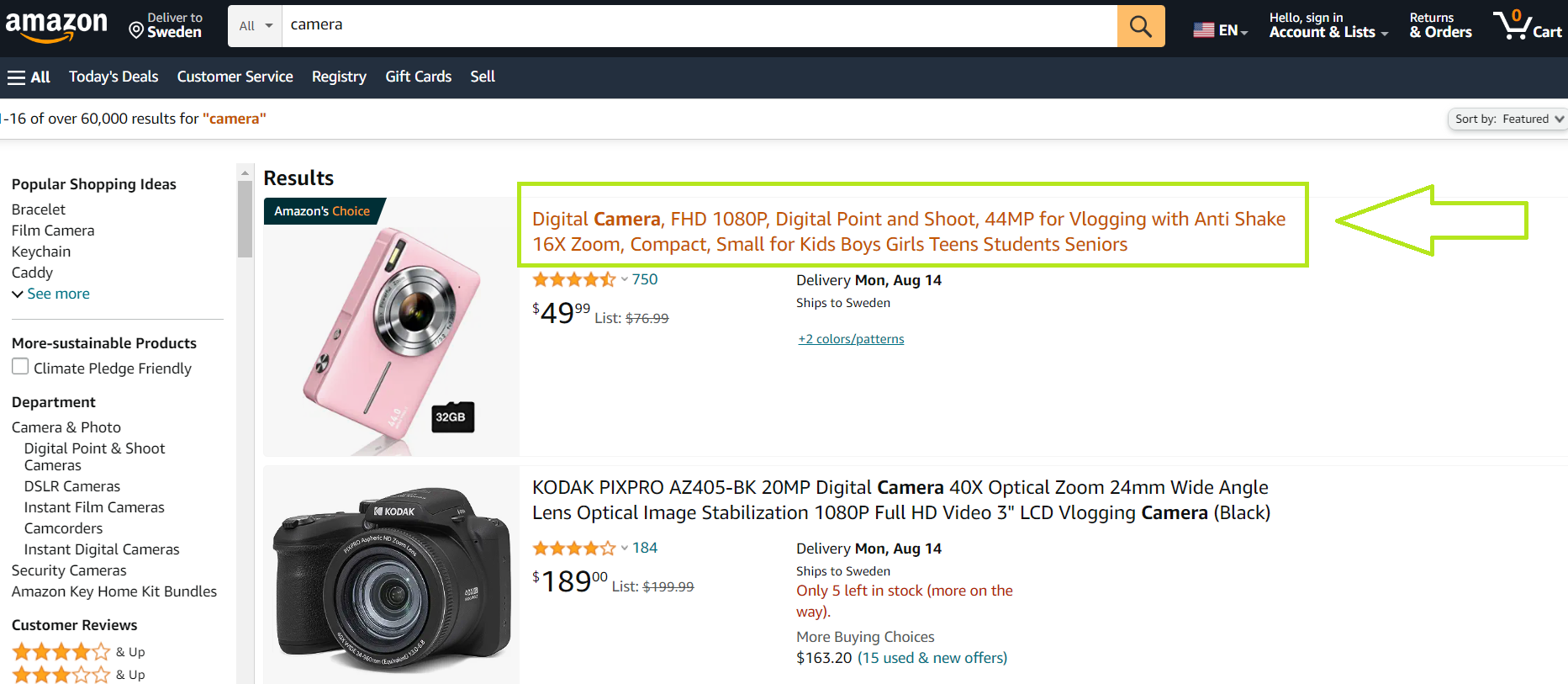
Product title example | Amazon
Bullets
Bullet points are where you describe the features and benefits of your product. You can include up to 5 bullets for each product.
Summarize the key features and benefits of the product. Keep it concise, highlighting 1 feature per bullet. This is another opportunity to insert relevant keywords, especially those that didn’t fit your title.
Amazon suggests keeping your bullet points under 1,000 characters in total (for all five bullets, not per bullet). Pay attention to format and length because these factors impact readability.
Here are a few tips for improving the quality of your bullets.
- Highlight the top five features that you want customers to consider
- Begin each bullet point with a capital letter
- Write in fragments and do not include ending punctuation
- Write all numbers as numerals
- Separate phrases in one bullet with semicolons
- Spell out measurements, such as quart, inch, or feet
- Do not use hyphens, symbols, periods, or exclamation points
- Do not write vague statements; be as specific as possible with product features and attributes
- Do not enter company-specific information; this section is for product features only
- Do not include promotional and pricing information
- Do not include shipping or company information. Amazon policy prohibits including seller, company, or shipping information
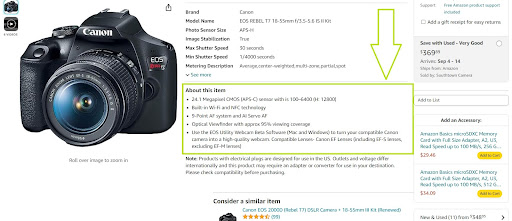 Amazon bullet points example | Amazon
Amazon bullet points example | Amazon
Description
Descriptions give customers more detail about what the product is used for and let you provide information that you couldn’t fit into the title or bullets. This is the chance to use your copywriting skills to say something compelling and entice visitors to buy.
Format the description so it’s easy for customers to read. Amazon allows basic HTML tags for paragraphs, line breaks, bolding, and bullet points, but any other HTML formatting is not allowed. Product descriptions are limited to 2000 characters.
Here are a few guidelines for writing descriptions:
- Describe the major product features, such as size, style, and what the product can be used for
- Include accurate dimensions, care instructions, and warranty information
- Use correct grammar, punctuation, and complete sentences
- Do not include any of the following types of information: Seller name, E-mail address, Website URL, Company-specific information, Details about another product that you sell, Promotional language such as “SALE” or “free shipping”
Images
Images are important to the customer’s decision-making process and are the main driver of clicks. The right product images will improve both your click-through rate and conversion rate. More traffic and better conversions will improve your product’s Amazon ranking and your sales.
Amazon’s standards for product images:
- The image must be the cover art or a professional photograph of the sold product. Drawings or illustrations of the product are not allowed.
- The image must not contain gratuitous or confusing additional objects.
- The image must be focused, professionally lit, and photographed or scanned with realistic color and smooth edges.
- Books, Music, and Video/DVD images should be the front cover art and fill 100% of the image frame. Jewel cases, promotional stickers, and cellophane are not allowed.
- All other products should fill 85% or more of the image frame.
- The full product must be in the frame.
- The image must not contain additional text, graphics, or inset images.
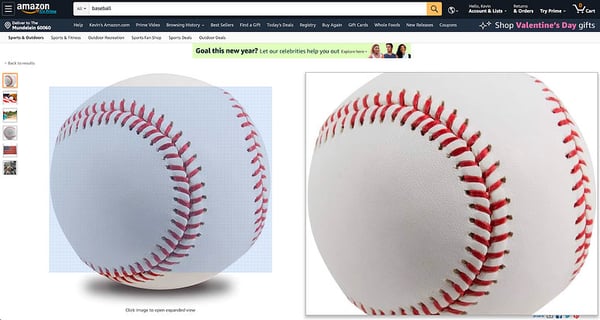
Example of a large, high-resolution image that enables zoom function | Amazon
Return to top of page or Double Your Amazon Sales With 9 Proven Tips
4. Get into the Buy Box
On Amazon, there is one product detail page for every item sold on the marketplace. Every seller offering that product shares the same product detail page. This contrasts with marketplaces like eBay, where multiple listing pages may appear for the same product.
The Buy Box is the section on the right side of a product detail page where the “Add to Cart” and “Buy Now” buttons are located. At any given time, a sale made through the Buy Box is awarded to only one seller.
Amazon rotates the Buy Box among sellers that offer the best buying options from the customer’s point of view. How often a seller “wins” the Buy Box depends primarily on the seller’s eligibility, fulfillment method, landed price, shipping times, and seller performance ratings.
Winning the Buy Box greatly improves your chances of getting the sale. To put it in perspective, 82% of Amazon sales go through the Buy Box. Non-Buy Box offers will appear in a less desirable position outside of the Buy Box.
Below we will cover just the basics of winning the Buy Box, but if you want a deeper dive into the topic, then read our in-depth article on winning the Buy Box.
.png?width=885&name=pasted%20image%200%20(9).png) Location of the Buy Box on a product detail page | Amazon
Location of the Buy Box on a product detail page | Amazon
Winning the Buy Box
Before you can compete for the Buy Box, your item must be Buy Box eligible.
Eligibility requirements:
- You must have a Professional seller plan
- The item for sale must be new
- The item must be in stock
.png?width=1121&name=pasted%20image%200%20(10).png) Item’s Buy Box eligibility in the Manage Inventory page of your Seller Central account | Amazon
Item’s Buy Box eligibility in the Manage Inventory page of your Seller Central account | Amazon
Once your item is Buy Box eligible, several factors determine if your offer will win the Buy Box. Here are the factors with the highest impact:
- Fulfillment Method - Amazon prefers products offered through programs that ensure quick delivery, like Fulfillment by Amazon (FBA) and Seller-Fulfilled Prime (SFP). Products sold through these programs have the best chance of winning the Buy Box.
- Landed Price - Amazon wants the customer to get the best deal. Amazon compares sellers based on the customer’s total landed price, which combines the product price, shipping cost, taxes, and handling fees. Having the lowest landed price won’t guarantee that you win the Buy Box, but it’s a key factor.
- Shipping Time - Amazon looks at how quickly you promise to ship the item to the customer. This takes into account transit time and handling time. The faster you can get the item to the buyer, the better.
- Seller Performance Metrics - Amazon measures sellers on many metrics, but a few have the highest impact on your Buy Box chances. The most critical Seller Performance metrics are Order Defect Rate (ODR) and Shipping Performance metrics. Go below Amazon’s targets, and you’ll likely see your share of the Buy Box plummet.
.png?width=1001&name=pasted%20image%200%20(12).png) ODR and Shipping Performance metrics on the Performance tab in Amazon Seller Central | Amazon
ODR and Shipping Performance metrics on the Performance tab in Amazon Seller Central | Amazon
Return to top of page or Double Your Amazon Sales With 9 Proven Tips
5. Scale your Amazon success internationally
To further scale your business on Amazon and boost sales, consider exploring opportunities with Amazon's international marketplaces. This allows you to reach a wider audience, hence increasing your potential customer base.
Additionally, keep optimizing your listings with relevant keywords and high-quality images for better visibility and conversion. Building a strong relationship with your customers through top-notch customer service can also lead to repeat purchases and positive reviews, further enhancing your credibility on the platform.
Consistent analysis and adaptation of your business strategies, in line with Amazon's tools and features, can significantly fuel your business growth on this expansive e-commerce platform.
What is Amazon Advertising?
Amazon Advertising is a powerful platform that amplifies the visibility of your products on Amazon, going beyond what organic search results can offer. This platform enables sellers and vendors to find, attract, and engage Amazon customers through various advertising solutions.
Before we cover advertising, let’s discuss the difference between selling and advertising on Amazon. When you offer a product for sale on Amazon, customers can find it organically through search results or recommendations on product detail pages. But Amazon is a crowded marketplace, and sellers may want more visibility for their listings than from organic placement alone.
Amazon Advertising lets you boost your products with better placement and increased frequency in search results and on product detail pages. Note that when you advertise on Amazon, you will pay advertising fees on top of any referral fees you owe on a sale.
It’s important to note that Amazon ads always direct customers to places within Amazon. You cannot use Amazon Advertising to send traffic to your own website, another marketplace, or anywhere outside of Amazon.
If you want to know how to advertise your Amazon product, you should get familiar with Amazon’s three most popular advertising solutions.
1. Sponsored ProductsThese ads are for individual products and will appear in search results and on product pages. In search results, the ads can appear at the top of the results page or sprinkle throughout the organic results. Sponsored Products are based on a cost-per-click (CPC) model. This means that the ads display at no charge, and ad impressions are free. The advertiser is only charged when a customer clicks on the ad.
You bid the maximum you’re willing to pay when a customer clicks on your ad. The higher your bid, the more likely your ad will be displayed on Amazon when it meets the ad’s targeting criteria. You can target Sponsored Products to appear when customers search for keywords or you can pick specific ASINs where you want your ad to appear. You can even run an automatic campaign and let Amazon decide how to target customers.
.png?width=1007&name=pasted%20image%200%20(16).png) Sponsored products | Amazon
Sponsored products | Amazon
2. Sponsored BrandsThese are banner ads that appear with a logo, a customized headline and may also include individual products. These appear only in the search results. Like Sponsored Products, Sponsored Brands is also based on a CPC model.
When Amazon customers click on your logo in a Sponsored Brands ad, they're taken to a Store or custom landing page. When they click on a product, they're taken to a product detail page. To use Sponsored Brands, you must first enroll in the Amazon Brand Registry.
.png?width=1003&name=pasted%20image%200%20(15).png) Sponsored Brands, Sponsored Products, and organic search results on the search results page | Amazon
Sponsored Brands, Sponsored Products, and organic search results on the search results page | Amazon
3. StoresAmazon Stores allow you to showcase your brand and products with a customized branded storefront. Stores are customizable using drag-and-drop tiles or predesigned templates. Here you can add banners, videos, and highly branded content.
Stores and Store pages can also be destinations when customers click on your Sponsored Brand ads. Creating a Store is free, but sellers must be enrolled in the Amazon Brand Registry. It is not necessary to advertise on Amazon to create a Store, but it’s unlikely many visitors will find your Store page organically.
.jpg?width=734&name=pasted-image-0-(17).jpg)
An example of an Amazon Store | Amazon
How to get customer reviews, and why do you need them?
Garnering product reviews on Amazon is integral to establishing trust, enhancing product visibility, and boosting sales. Reviews serve as social proof, with potential customers often gauging the quality and reliability of a product based on existing customer feedback. A higher number of positive reviews can significantly increase the conversion rate, as they help mitigate potential risks and uncertainties associated with online shopping.
Here are some actionable steps to encourage reviews on Amazon:
- Request Reviews: Use Amazon’s 'Request a Review' button which sends an email to the customer asking for a review. Be mindful that Amazon has strict guidelines for reviews, so always ensure your requests align with their policies.
- Provide Excellent Customer Experience: Outstanding customer service often encourages customers to leave positive reviews. Quick responses to queries, efficient problem-solving, and showing appreciation can go a long way in earning good reviews.
- Follow Up: Send follow-up emails to customers to check if they are satisfied with their purchase and kindly ask for a review.
- Amazon Early Reviewer Program: Enroll in this program which encourages customers who have recently bought your product to share their experiences in a review. This can be especially helpful for new products that haven't gathered many reviews yet.
Remember, while it's essential to accumulate reviews, it's more important to ensure they are genuine and organic. Avoid offering incentives for reviews as this violates Amazon's policies and can lead to penalties.
What is Amazon Prime?
Amazon Prime is a paid membership program that gives customers free and fast shipping on their purchases. Customers pay an annual membership fee and get two-day shipping or better on any Prime-eligible products. It’s a popular program, and over 149 million Americans are Prime subscribers.
.png?width=1143&name=pasted%20image%200%20(8).png)
An example of a Prime-eligible listing | Amazon
Offering Prime-eligible products is great for merchants because customers prefer free and fast shipping. Also, the Buy Box algorithm prioritizes selling options that are Prime-eligible.
Merchants can sell on Amazon Prime in two ways:
- Items sold through Fulfilled by Amazon (FBA) are automatically eligible
- Items Fulfilled by Merchant (FBM) require the merchant to enroll in Amazon Seller Fulfilled Prime (SFP).
Seller Fulfilled Prime
Seller Fulfilled Prime allows FBM merchants to list products as Prime-eligible. The Prime badge will appear on products that are shipped directly to customers with two-day shipping and free standard shipping. Prime offers can boost sales but remember, the merchant is still fully responsible for the shipping cost.
There is no fee to enroll in Seller Fulfilled Prime, but merchants must meet strict performance standards and complete a trial period. New sellers will have to build a seller performance history before applying for the program.
Performance standards include:
- A cancellation rate of less than 1%
- An on-time shipment rating of at least 99%
- Use of Buy Shipping Services (purchasing shipping through Amazon) for a minimum of 95% of the orders
What is Amazon A+ Content?
Amazon A+ Content (previously known as Enhanced Brand Content (EBC), is a program that gives sellers more detailed product descriptions. This helps increase conversion and sales.
Amazon A+ Content lets you make product descriptions more attractive and visually aligned with your brand. It’s a great way to highlight the product’s features and benefits better. Sellers can add more detailed images and use additional text placements to provide a more comprehensive product description.
Amazon A+ Content is available to Sellers and Vendors who are brand owners. Before you can get started with A+ Content, your brand must be enrolled in the Amazon Brand Registry (covered later in this article).
Want to learn more? Check out our in-depth article on Amazon A+ Content.
What is the Amazon Brand Registry?
The Amazon Brand Registry is a program that gives brand owners greater control over their product listings and their intellectual property on Amazon.
This is especially useful for brands that have issues with counterfeit products or unauthorized dealers appearing on Amazon. Enrolled brands can report suspected violations to Amazon. Also, Amazon can proactively remove suspected infringing or inaccurate content.
Enrolling in the Amazon Brand Registry is also a prerequisite for getting access to A+ Content, advertising using Sponsored Brands, and Amazon Stores (covered later in this article).
Amazon Brand Registry Requirements
To enroll in Amazon Brand Registry, you need to meet certain requirements. First, your brand must have an active registered trademark in each country where you wish to enroll or have a pending trademark application filed through Amazon IP Accelerator.
Amazon IP Accelerator is a network of pre-vetted law firms that help businesses obtain intellectual property (IP) rights. A trademark application can take months to process. Filing your application through Amazon IP Accelerator lets you gain access to Amazon Brand Registry before the trademark is issued.
The trademark must be a text-based mark (word mark) or an image-based mark with words, letters, or numbers (design mark).
Examples of accepted trademarks | Amazon
Return to top of page or Double Your Amazon Sales With 9 Proven Tips
Conclusion
Venturing into the world of Amazon selling may appear daunting initially, but with the right knowledge and tools at your disposal, it transforms into an exciting entrepreneurship journey. This guide has aimed to provide you with a comprehensive understanding of how to set up shop on Amazon, making the most of its seller-friendly features and optimizing your product listings for maximum visibility.
Always remember success on Amazon is a blend of strategic planning and consistent effort. With patience and perseverance, not only can you become an active part of Amazon's thriving seller community, but also tap into the boundless potential that e-commerce offers. So gear up. The world of Amazon selling awaits you!
Read next: Get Returning Customers on Amazon
Grow Your eCommerce Sales by Expanding to New Channels:
- How to Sell on Wish - A Complete Guide for Retailers
- How to sell on Kogan AU: A Step by Step Guide
- How to Sell in Onbuy - Beginner's Guide
- Start Selling with Awin - Beginner's Guide
- Start Selling on Bol - Beginner's Guide
- Start Selling on Idealo - Beginner's Guide
- Start Selling on Criteo - Beginner's Guide
- Start Selling on eBay - Beginner's Guide
- Selling with Rakuten: The Ultimate Marketplace Guide
- Start Selling with Facebook Dynamic Ads for Retail - Beginner's Guide
- A Guide to Successful Selling on the Bonanza Marketplace
- How to Optimize Your Amazon Listing for Mobile in 2021
.png?width=1011&name=pasted%20image%200%20(14).png)
